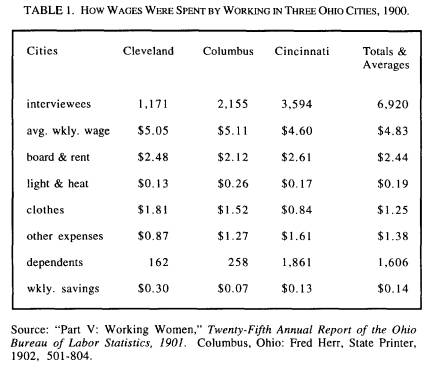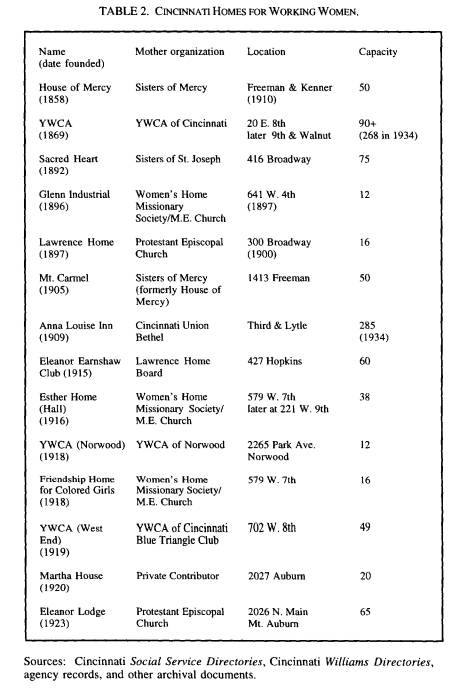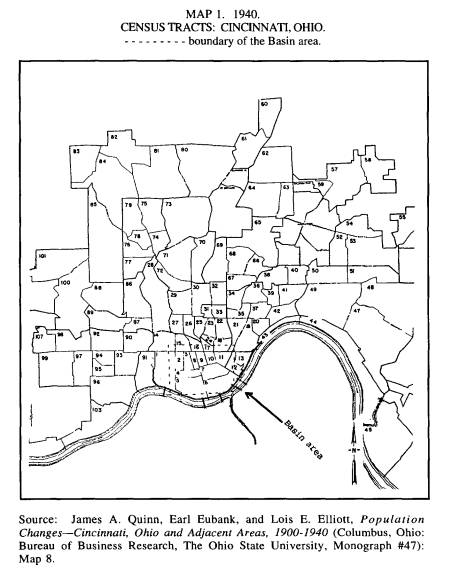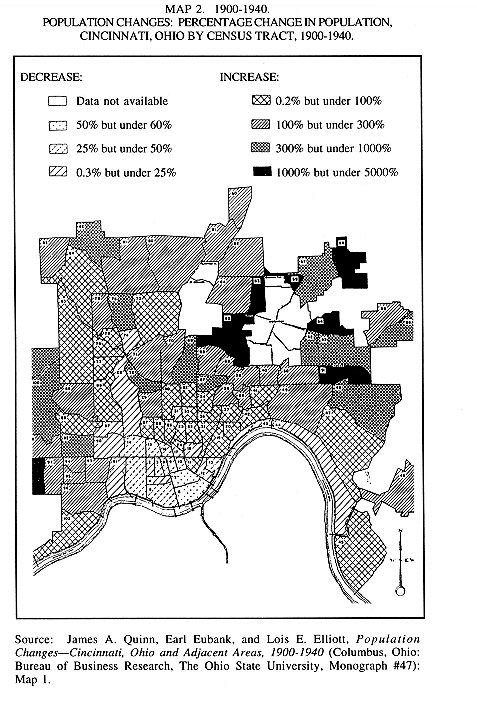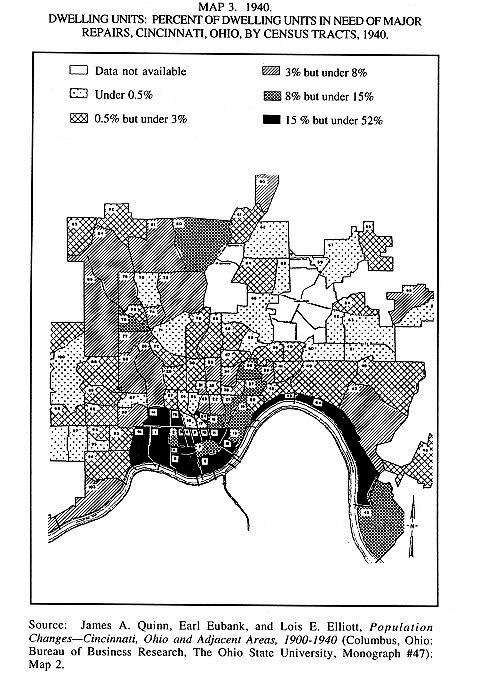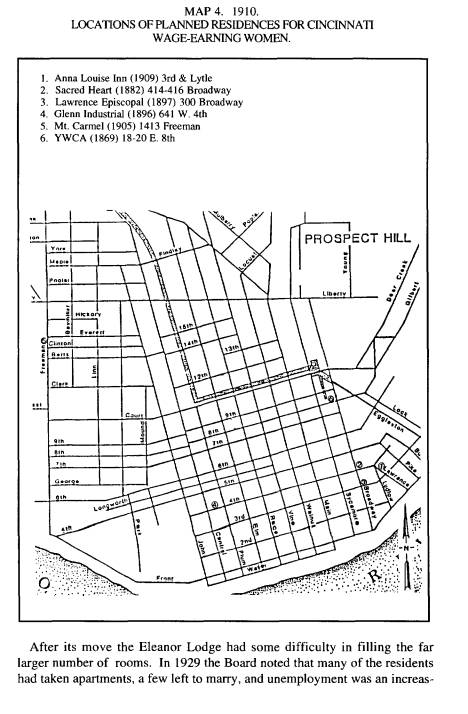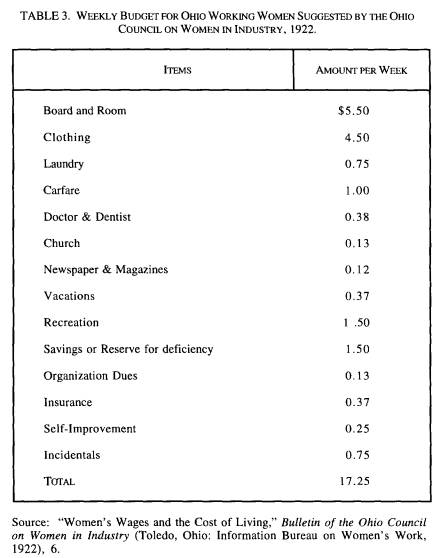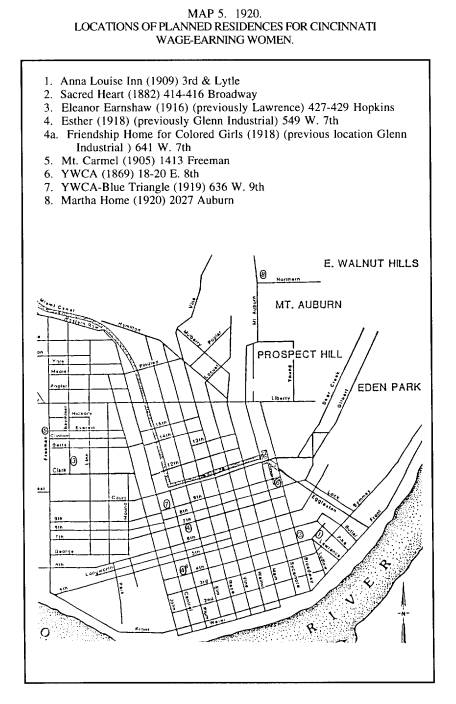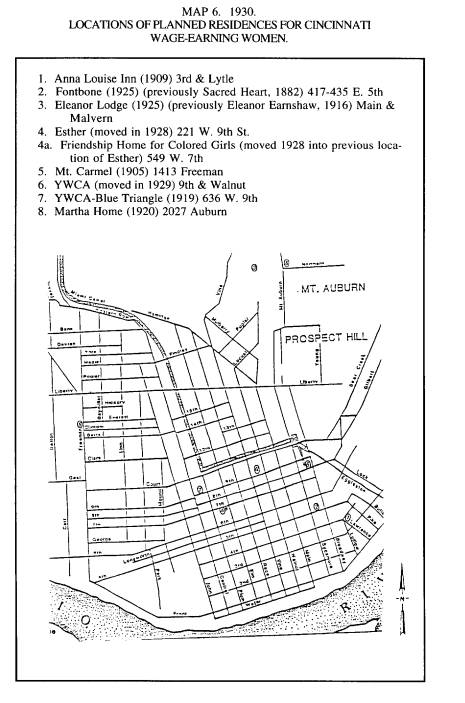Ohio History Journal
- 1
- 2
- 3
- 4
- 5
- 6
- 7
- 8
- 9
- 10
- 11
- 12
- 13
- 14
- 15
- 16
- 17
- 18
- 19
- 20
- 21
- 22
- 23
- 24
- 25
- 26
PATRICIA A. CARTER
Housing the Women Who Toiled: Planned
Residences for
Single Women, Cincinnati
1860-1960
The Lawrence [Home] stands as a barrier
to sickness and evil, she opens her doors
and invites the young, unprotected girl
to come in and make her home here-not
that she may be rescued as a brand from
the burning, but that she may not even get
near enough to the fire to be scorched.
She does not consider herself, nor is she
considered, a charity inmate. Her
independence and self-respect are guarded and
fostered by the management, although her
three and a-half dollars (sometimes the
larger part of her week's earning) does
not cover the expense of her maintenance.1
The above statement illustrates the
sentiments regarding many single,
women workers at the turn of the
century. Those separated from their fami-
lies and working long hours for low pay
were viewed as morally and physi-
cally vulnerable to the hazards of urban
life. By the early 1900s many cities
had established homes for unwed mothers
or reformatories for women who
"went bad." However,
residences for working women were seen, as the quote
suggests, as a preventive measures to
such deplorable outcomes. The move-
ment to provide safe and affordable housing
to single working women began
in England and moved to the U.S. in the
late nineteenth century. Throughout
the early twentieth century religious
groups and social service providers es-
tablished homes for the protection and
comfort of this new group of workers
in cities throughout the country.
Cincinnati was the third U.S. city to estab-
lish a home for women workers, when in
1858 the Sisters of Mercy founded
the House of Mercy. By 1930 at least
nineteen such institutions had opened
in the city. Though only one of the
homes still remains, this study finds
that the planned residences were
generally successful in providing their in-
tended services.
Previous research on the history of
housing for working women has tended
to focus primarily on an analysis of
specific homes and the degree to which
middle-class ideology dominated the
day-to-day interactions within them.2
Patricia Carter is on the Women's
Studies faculty at the University of Connecticut.
1. Annual Report of the Lawrence
Home, (n.p.: November 4th, 1908), 4-5.
2. M. Christine Anderson, in "Home
and Community for a Generation of Women: A Case
Study of the Cincinnati YWCA Residence,
1920-1940," Women in Cincinnati: Century of
Achievement, 1870-1970. (Cincinnati, 1987), 34-41; Lisa Fine, "Between Two
Worlds:
Business Women in a Chicago Boarding
House, 1900-1930," Journal of Social History, 19
Housing the Women Who Toiled 47
This essay provides another perspective
by taking an overview of planned
housing of this type in one city,
Cincinnati, over a period of one century.
This macro focus allows for a more
holistic review of the planning, devel-
opment, growth and decline of the
planned boarding units.
Several factors make a study of
Cincinnati's planned housing for working
women particularly interesting,
including: its early status as a major
Midwestern industrial city; the city's
centrality in the African-American
Diaspora; its large population of Reform
Jews; and its geographic location as
a basin city (bounded by the Ohio River
to the south and hillsides on the
other three). The importance of this
last factor is its influence in keeping
Cincinnati a walking city, meaning one
which could be traversed from one
side to the other without difficulty or
a lengthy amount of time. It therefore
remained a residential city for a longer
period than those not constrained by
similar geographical barriers.3 This
essay will show how the planned resi-
dences for women responded to shifts in
the city's population, deterioration
of the urban core, and general movement
to suburbanization.
Other evidence from this research
indicates that though homes for white,
middle-class women were better funded
and more prevalent, the needs of older,
working-class, Jewish and
African-American women were not completely ig-
nored. When viewing the history of these
latter homes one can see both the
rise of an era of interracial
cooperation on social service boards but also the
ease with which planners gave into
racism, ageism, and classism that created
the necessity for separate homes in the
first place.
Background on Homes for Single Women
The development of special housing for
single working women corre-
sponded to the increasing percentage of
young, white, native-born women in
the U.S. labor force in the latter part
of the nineteenth century. Higher educa-
tion, the women's movement, urbanization
of jobs, immigration, and migra-
tion patterns of southern
African-Americans contributed to the acceleration of
the female work force in Cincinnati and
the U.S. at-large. The image of this
group of neophyte laborers elicited the
sympathies of urban reformers and
drove them to develop an infrastructure
to secure the protection of the naive
farm girl in the big and friendless
city. Illustrative of this concern were the
(Spring, 1986), 511-19; Joanne
Meyerowitz, "Women Adrift": Wage-Earning Women Apart
from the Family in Chicago, 1880-1930 (Chicago, 1989); Lynn Weiner, "'Our Sister's
Keeper': The Minneapolis Woman's
Christian Association and Housing for Working Women,"
Minnesota History 64 (Spring, 1979),189-200.
3. For more information on the
relationship of Cincinnati's geography to its development see
Zane Miller, Boss Cox's Cincinnati:
Urban Politics in the Progressive Era (New York, 1968),
3-56; Glenn Miller, "Transportation
and Urban Growth in Cincinnati, Ohio and Vicinity: 1788-
1980" (Ph.D. dissertation,
University of Cincinnati, 1983).
48 OHIO
HISTORY
ads placed in small-town papers and in
train stations warning young women
not to move to urban areas without a
secure promise of employment or an
adequate means of support. Despite such
precautions, the allure of the city
prevailed, so reformers established
alliances with Traveler's Aid societies and
railroad workers who could direct new
arrivals to appropriate services or shel-
ters.4 The scarcity of jobs
and affordable housing was aggravated by the fact
that hoteliers and boarding housekeepers
often preferred male over female resi-
dents, believing that men were less
trouble.5 As a result women's wages,
only one-third to one-half their male
counterparts,' had to be stretched farther.
Comfortable housing in safe
neighborhoods came at a premium. Food was
more expensive for women who ate in the
better restaurants because the
cheaper ones were located in bars or in
bad neighborhoods. These difficulties
were further complicated by racism and
ethnocentrism, as well as the prevail-
ing middle-class values and expectations
of urban reformers and the piety of
the religious groups which sought to
rescue women from the streets.
The history of the women's housing
movement is inextricably tied to the
consumer reform movement which had its
origins within the women's suf-
frage movement. Margaret Gibbons Wilson
notes three types of early twen-
tieth century urban reformers: the civic
reformers who campaigned for a clean,
efficient government and an end to
"bossism"; the social reformers who
struggled to ameliorate the hardships of
urban life such as housing, disease,
and unsafe working conditions; and the
city planners who worked to rational-
ize and beautify the urban environment
in the hope of bettering the lives of
its inhabitants. It is safe to say that
all three movements played a part, often
simultaneously, in the development of
housing for working women.6
Aside from family homes, women workers
lived in a variety of structures:
lodging houses, apartments, boarding
houses, and employer-owned or subsi-
dized facilities. Lodging houses offered
sleeping quarters but not eating ac-
commodations. Boarding houses provided
renters with both an individual
sleeping room and a common dining room.
Apartment and tenement houses
were generally family units, in which
rooms were rented to boarders and food
4. Evidence of this can be seen in:
"A Philadelphia Warning to Girls," Religion and Social
Service, 46 (February 1, 1913), 234, which stated that the
Commission on Social Service of the
Philadelphia Interchurch Federation had
published warnings in the newspapers to "girls
throughout the country not to be led
into going to big cities unless they have been assured of
honest employment at more than $8 a
week"; or in Mrs. Newell Dwight Hillis, "The Home
Life of Working-Girls," The
Outlook, 98 (May 14, 1911), 72-75, which discussed the rising
number of young, inexperienced women
workers falling into "white slavery." See also
Florence Kelly, "Why Working Girls
Fall into Temptation," Ladies Home Journal, 26
(November, 1909),15-16; Harriet
Brankenhurst, "The Business Girl and the Confidential
Man," Ladies Home Journal, 28
(March 15, 1911), 26.
5. Lynn Weiner, From Working Girl to
Working Mother: The Female Labor Force in the
United States, 1820-1980 (Chapel Hill, 1985), 53.
6. Margaret Gibbons Wilson, The
American Woman in Transition: The Urban Influence,
1870-1920 (Westport, 1979), 93.
Housing the Women Who Toiled 49
preparation facilities were at times
included.7 Employer-owned housing was
designed similarly to the boarding house
but offered, at least, partially subsi-
dized rents. Finally, domestic workers
sometimes boarded with their employ-
ers, usually in small sleeping quarters
above the main house.
Mainstream housing theory of the period
generally ignored the housing
needs of single, working women. Housing
developments in England and the
U.S. focused almost exclusively on the
needs of working-class families.
Morris Knowles' Industrial Housing, considered
a critical work of its time,
clarified the general sentiment of
planners when he stated that: "Special build-
ings for housing women will, in
developments, be found unnecessary."8 The
response to working women's housing
needs came first from religious soci-
eties. Protection of the virtue of
working women from the moral depravity
of urban life provided a key explanation
for the intervention of these groups.
The roots of their interest began with
housing "fallen women," unwed moth-
ers or former prostitutes, who turned to
such organizations in contrition or as
their only means of getting off the
streets.
The transition into housing for young
working women came as reformers
began to recognize the dilemma faced by
naive young rural women when they
arrived in the big city seeking
employment.9 The origin of the homes for
Cincinnati working women is so closely related
to that of institutions for
"errant women" that it is
often difficult to discern between the two when
looking through primary documents.
During the first decades of their devel-
opment such residences were listed in
social service directories along with
those for such special populations,
cited as "incurables, invalids, elderly, in-
sane, and fallen women."10 The
Convent of the Good Shepherd opened four
homes in the Cincinnati area with a
two-fold purpose: "Bring back to the
pathways of virtue the unfortunate young
women who have strayed," and to
"shelter from peril young girls,
both white and colored, as yet innocent of
sin, but sorely exposed to untoward
social environments." 11 It could not be
determined what percentage of each group
constituted the Good Shepherd
homes or whether the two groups were
kept separated.
7. Albert Benedict Wolfe, The Lodging
Problem in Boston (Boston, 1906), 5.
8. Morris Knowles, Industrial Housing
(New York, 1920), 340-41.
9. See for instance "Her Sister in
the Country Who Wants to Come to the City to Make Her
Way," Ladies Home Journal, 28
(Spring, 1911), 16; Alice N. Lincoln, "Some Ways of
Benefiting a City: Working Girls
Homes," The American Monthly Review of Reviews, 18
(November, 1898), 604.
10. See for example Bureau of Census
Benevolent Institutions 1910 (Washington, D.C.,
1913) which lists homes for working
women with those for the aged, infirm, destitute, incur-
able, epileptics and convalescents; and
the 1900 Williams Cincinnati Directory (Cincinnati,
1900), 291-92.
11. Charles Frederic Goss, Cincinnati:
The Queen City, 1788-1912 (Cincinnati, 1912), 282.
|
50 OHIO HISTORY |
|
|
|
Two 1898 publications established early twentieth century standards for working women's housing. In the first, Mary S. Ferguson of the U.S. Department of Labor described the ideal boarding place as one in which "working girls and young women of good moral character can live at prices within their reach, in which they can find . . . the conveniences, social plea- sures, and good influences of a real home, and ... many comforts and wide opportunities for pleasure and culture."12 Concerned about homes "with the odor of charity," the author cautioned her readers "to distinguish between phi- lanthropic effort and charity."13 Ferguson also objected to unnecessary rules and suggested that administrators offer advice instead of interference. Future buildings, she insisted, should afford workers greater privacy in the form of individual sleeping rooms and rates which accommodated factory workers. The second publication, "Girls' Cooperative Boarding House," described the "women's hotel of the future." Author Robert Stein presented his vision of a "gigantic but elegant building" which featured a public dining room on the
12. Mary S. Ferguson, "Boarding Homes and Clubs for Working Women" Bulletin of the Department of Labor, 15 (March, 1898), 141. 13. Ibid., 142. |
Housing the Women Who Toiled 51
ground floor opened to both women and
men.14 The restaurant would subsi-
dize the hotel as well as employ some
residents as waitresses and cooks. The
training they received in these
positions would allow them eventually to
move to better paying positions outside
the hotel. Courses in dressmaking,
millinery, stenography, typing,
bookkeeping, photography, and typesetting
would be offered to residents as well as
free and regular lessons in "language,
elocution, dancing and physical
culture." Stein imagined that the hotel would
function as a place where society ladies
and girls of humble origins could mix
freely and engage in uplifting
activities such as literary and scientific clubs,
and dramatics and musical exercises. A
membership committee would screen
men invited to coed activities to ensure
that only "gentlemen" were admitted.
The hotel would also operate a farm on a
body of water about ten miles from
the city. There a spacious villa,
playgrounds, fields, orchards, boats, and
sandy beaches would provide a vacation
resort where tired the city dwellers
could recuperate in play and pleasant
work. An open invitation would be is-
sued to young rural women and men to
come and socialize with the city
women and participate in the educational
and evening offerings at the resort.15
Both of these early publications
exorcised the notion of charity as a primary
force in the establishment of homes for
working women, preferring instead to
consider the homes "endowed"
in the manner of other community services
such as libraries, schools, museums, and
hospitals.
Working Women in Cincinnati
The employment patterns of Cincinnati
women were fairly consistent with
those of the female U.S. labor force
at-large. The average single, white fe-
male worker in 1888 was just over 22
years old. She began work at age 15
and had been employed in her present
occupation for five years. She was
likely to have been born in the U.S. (81
percent) but of foreign-born parents
(74 percent fathers, 71 percent
mothers), most notably either Ireland or
Germany.16 Since men and
women participated about equally in the 1890-
1910 migration from the southern U.S.,
African-American women entered the
Cincinnati labor force in large numbers.
During this period the total number
of African-American women increased by
57 percent and single women by 63
percent. Of the single women 61 percent
were between the ages of 15 and 24
and 32 percent between 15 to 19 years
old.17 By 1910, 49 percent of all
14. Robert Stein, "Girls'
Cooperative Boarding Clubs," Arena, 19 (March, 1898), 397-417.
15. Ibid.
16. Working Women in Large Cities:
Fourth Annual Report of the Commissioner of Labor
(Washington D.C., 1889), 268-69.
17. William Loren Katz, ed., Negro
Population in the United States, 1790-1915, William
Loren Katz, editor, (New York, 1968),
273-76.
52 OHIO
HISTORY
Cincinnati African-American women over
the age of 16 worked outside the
home.18 In Ohio the largest
percentage of African-American workers engaged
in laundry (32 percent) and tobacco
factory (43 percent) labor.19
Women's employment was generally
characterized by low pay, long hours,
and unhealthy conditions. Wages in 1900
averaged $4.60 for a 58 hour
week.20 Employers' assertions
that women worked only to buy luxuries
were disputed by surveys such as those
done by the Ohio Bureau of Labor,
which clearly indicated that female
employees had difficulties in meeting ba-
sic survival needs. 21 Table 1
illustrates the amounts spent by the average
Ohio female wage earner for basic needs
in 1900. Board, rent, light and heat
consumed over one-half of the average
worker's wage, leaving transportation,
health care, entertainment, and laundry
to be bought with a mere $1.38. A
more descriptive picture of the living
conditions afforded by the wages allot-
ted Cincinnati women was provided by
another survey which offered individ-
ual portraits of workers contained in
the aggregate statistics.22
Number 23
Packer in a cracker factory. Is probably
over 30 years of age, altho [sic] exact age
was not reported. Has had nearly 15
years experience in factory work. Began as a
minor, in a paper box factory, working
as a turner and a stitcher and finally ad-
vancing to assistant forelady. Due to a
seemingly justifiable cause, she left and
began work for a far lower wage. Does
her own sewing and sewing for a relative,
in return for which relative does her
laundry for less than market rate. Goes to
night school (free) and her desire for
improvement is evidenced by her entries for
lessons in dressmaking. Lives in 1 room
where she does light housekeeping.
Keeps her room neat and clean. Gets only
one real meal a day. Goes irregularly to
relatives in better circumstances for a
considerable number of meals. She has a
passion for flowers, but indulged
herself only to the extent of $0.50 worth during
the year. Rather more resigned than
cheerful. Factory conditions where she
works, according to her statement, are
without a menace to health. 23
Number 31
She is a bindery employee. Wages $7.00
per week, thirty-three years of age and
had five years and nine months
experience at bindery work, besides two years at
labeling. Her work was irregular on
account of her mother's poor health. If this
worker was not living in a boarding home
for working girls her condition would
be very serious, as she has been out of
work for fifteen weeks during the past year.
She has had to neglect some dental work
that she really should have had done, as
18. David A. Gerber, Black Ohio and
the Color Line, 1860-1915 (Urbana, 1968), 278-79.
19. Negro Population, 522.
20. Working Women in Large Cities, p.
17; Work and Wages of Men, Women and Children:
Eleventh Annual Report of the
Commissioner of Labor, 1895-96 (Washington
D.C., 1897), 30-
31.
21. "Part V: Working Women," Twenty-Fifth
Annual Report of the Ohio Bureau of Labor
Statistics (Columbus, 1902), 802-03.
22. Dept. of Investigation and
Statistics, Cost of Living of Working Women in Ohio
(Columbus, 1915).
23. Ibid., 175-76.
Housing the Women Who Toiled 53
she had no money to pay for it. She has
been in the habit of keeping an account
of her income, but her expenditures are
so nearly confined to absolute necessities
that she had not previously kept account
of them . . . her most unusual expenditure
is for a newspaper in order to look in
the want columns for work.24
Each of these portraits demonstrated the
frugality required of female workers.
Though in their thirties, both continued
to live hand-to-mouth existences,
sacrificing nutritional and physical
needs because of poor wages. In the case
of Number 31, one wonders whether the
boarding home for working girls was
able to provide the same type of support
structure provided Number 23 by her
relatives with whom she shared meals and
traded sewing for laundry duties.
The Origins of Housing for Cincinnati
Working Women
An 1888 U.S. Commission of Labor survey
of women who worked in
large cities found that the percentage
of working women living at home was
higher in Cincinnati than any of the
other twenty-one studied. Though this
was generally thought to indicate good
housing conditions, the survey author
noted otherwise, declaring that the
homes of Cincinnati working women were
"unusually uninviting."
The streets are dirty and closely built
up with ill-constructed houses, holding from
two to six families. Many of the poorer
parts of Cincinnati are as wretched as the
worst European cities, and the
population looks as degraded. Rents are dispropor-
tionately high and commodities dear. 25
Cincinnati compared poorly with other
midwestern cities such as Cleveland
where "separate houses, good
sanitation, comfortable surroundings, and a
general respectability are the rule
rather than the exception, and extreme
poverty is rarely witnessed." The
survey also noted that working women in
Indianapolis lived in
"cottages" which as a rule were neat and comfortable
with moderate rents. 26
Only one Cincinnati residence, the
Sacred Heart, founded in 1882, was in-
cluded in the survey. The home, managed
by a Miss McCabe, charged rents
which ranged from $1.00 to $3.00 a week.
Despite the rather high rates, the
survey noted it was crowded with four to
seven women sharing each tiny
sleeping room. Compared to the
"airy cottages" of Indianapolis, the Sacred
Heart seemed squalid and illustrated a
critical need for additional housing for
Cincinnati working women.
24. Ibid., 197-98.
25. Working Women in Large Cities, 17.
26. Ibid., 18.
Housing the Women Who Toiled 55
The report failed to mention the
existence of two similar homes: the House
of Mercy founded in 1858, and the YWCA
residence opened in 1868. Several
other units opened in the following
decades. Between 1858 and 1930 nine-
teen planned residences for single women
were developed in Cincinnati.
Some were short-lived, others merged,
and only one, the Anna Louise Inn,
remains in existence today. There is scant
information on several of the in-
stitutions, as many of the original
records have either been destroyed or are
privately held. But available
information suggests that particular ethnic, reli-
gious, and racial groups set up their
own homes, often with financial assis-
tance from white philanthropists. For
instance, by 1924, four homes had
been established for African-American
women: the Home for Colored Girls,
Colored Catholic Girls Home, the
Evangeline Booth Home for Colored Girls
(for unwed mothers), and the Cincinnati
Friendship Home. The first, the
Home for Colored Girls (HCG), was
founded in 1911 by the Cincinnati
Protective and Industrial Association
for Colored Women and Girls, a group
composed of local philanthropists and
reformers, both African-American and
white.27 The absence of
hotels and boarding houses open to African-
Americans in the city indicated a
critical need for the facility. The founders
intended the HCG to serve women, ages 14
to 35, seeking employment in
the city. Train depot employees and
volunteers greeted visitors with informa-
tion about the facility on their
arrival.28 Despite its initial success, after less
than a year the organizers abruptly
changed its mission to a home for younger
girls from "broken and troubled
homes."29
The Friendship Home, which opened in
1918, became the first permanent
planned residence for African-American
working women in Cincinnati.30
Though many of its residents came to the
city hoping to find industrial labor
connected to the war effort, few found
anything except domestic service, until
the mid-1920s when white-collar
opportunities such as teacher, social worker,
nurse, and librarian began to open to
African-American women.31 The Home
required each boarder to attend church
services. Piano and voice lessons were
offered regularly, and some residents
participated in the Friendship Home
Choir which performed at events
throughout the city to raise funds for the fa-
cility.32
The Blue Triangle Club, the West End
Branch of the Cincinnati YWCA,
27. Williams Directory of Cincinnati (Cincinnati,
1969), 326; Goss, Cincinnati: The Queen
City, 324.
28. Gerber, Black Ohio, 449-50;
Frances Kellor "Assisted Emigration from the South-the
Women," Charities, 17
(October 7, 1905), 12.
29. Home for Colored Girls (n.p.:
n.d.). Pamphlet located at the Cincinnati Historical Society.
30. Goss, Cincinnati: The Queen City,
324.
31. Ruth Esther Meeker, Six Decades
of Services, 1880-1940: A History of Woman's Home
Missionary Society of the Methodist
Church (n.p., Methodist Episcopal
Church, 1969).
32. Ibid.
56 OHIO
HISTORY
opened in 1919, accepting women ages
from 14 to 35.33 Both transients and
permanent members were welcome and fees
were based on ability to pay.
The three-story, twelve-room building
was largely supported by contributions
from local churches and lodges. The
first and second floors of the building
were used for club and recreational
purposes, and the third story was a dormi-
tory. 34 The name "the Blue
Triangle Club" was given to African-American
branches of the YWCA throughout the
country.35 The home ran a laundry,
the proceeds from which helped to
support the facility. Women who could
not find employment worked in the
laundry in exchange for their room and
board.36 A day nursery, also
housed in the facility, provided another em-
ployment opportunity for residents.
Working mothers could leave their chil-
dren at the center for five cents a day.37
A tea room served as a meeting place
for residents and nonresidents at an
affordable price. Recreational facilities in-
cluded a gymnasium, swimming pool, and
basketball and tennis courts which
were available to nonresidents as well.38
David Gerber contends that
African-American women's clubs of this period
tended to neglect the real needs of the
migrant poor. Unable to understand the
struggles of the too distant
lower-class, African-American clubwomen offered
them little more than platitudes.39
Gerda Lerner, however, suggests that
African-American women were deeply
involved in social work.40 In
Cincinnati it would appear that both
views had merit. African-American
women certainly were present on the
interracial boards which helped to de-
velop the planned residences for this
group of working women. However,
records do not explain to what extent
they were also key actors in the concep-
tualization and maintenance of these
projects.41 The Martha House, operated
by the Jewish Social Services and funded
primarily through the contributions
of one anonymous donor,42 appeared
to fill a specific need. When it opened
in 1920 the few Jewish women residing at
the YWCA left for the Martha
House, perhaps indicating that the 'Y'
had offered a less than hospitable
33. Wendall P. Dabney, Cincinnati's
Colored Citizens: Historical, Sociological, and
Biographical (New York, 1922), 216-18.
34. Ibid., 210.
35. Jane Olcott, The Work of Colored
Women (New York, 1919), 106-07.
36. Dabney, Cincinnati's Colored
Citizens, 210.
37. "Friendship Home Statement to
the Public," The Union, 14 (January 18 1920), 1.
38. Ibid.
39. Gerber, Black Ohio, 113.
40. Gerda Lerner, Black Women in
White America: A Documentary History (New York,
1972), 435-58.
41. Jane Edna Hunter's A Nickel and a
Prayer (Nashville, 1940) provides an interesting de-
scription of her struggle to gain
interracial cooperation in establishing a home for African-
American single working women in
Cleveland.
42. Frances Ivins Rich, Wage-Earning
Girls in Cincinnati: The Wages, Employment,
Housing, Food, Recreation, and
Education of a Sample Group (Cincinnati,
1927), 30.
|
Housing the Women Who Toiled 57 |
|
environment to its Jewish residents.43 Located on Auburn Avenue in Mt. Auburn in a section of Jewish homes (Map 1), this residence was the first to situate itself outside the walking city, forcing the residents to use public transportation to jobs downtown.
43. Anderson, "Home and Community," 36. |
58 OHIO HISTORY
Providing housing to women employed in
industrial occupations was an
initial goal of most of the planned
residences. Yet the evidence suggests that
this represented the planners' greatest
failure as facility after facility admitted
increasing numbers of white-collar
workers. This seems to have been related
to the fact that industrial workers,
with little formal schooling, earned less,
worked longer, and were older than their
white-collar counterparts. As a re-
sult they had less money to spend on
room and board. An example of this
dilemma can be seen in the Anna Louise
Inn, founded in 1909. The Union
Bethel, Cincinnati's oldest social
service institution, began its activities in
1830 with the goal of providing decent
living quarters and religious services
to riverboat workers along the
Cincinnati wharf area.44 In the style of the
Hull House in Chicago and Toynbee Hall
in London, the Union Bethel set
up, in 1900, a settlement house serving
19 blocks of Cincinnati's most im-
poverished population. Boys' and girls'
clubs were formed, a gymnasium and
library organized, public baths
installed, and Cincinnati's first kindergarten
established in the settlement. In 1906,
the Union Bethel opened a lunchroom
for women working in nearby factories.
It was through this effort that the
trustees learned of the need for better
housing for women workers and resulted
in the building, in 1909, of the Anna
Louise Inn for Working Women.45
The Inn, named after the daughter of
Charles P. and Anna Sinton Taft, ma-
jor donors in the construction of the
facility,46 became the largest home for
working women within Cincinnati. The
five-story brick and terra-cotta build-
ing had the latest amenities, including
steam heating and gas lighting.47
The home had 120 single sleeping rooms,
several parlors for entertaining
guests, a dining room, and offered
social, religious and educational activities.
Richly furnished with oriental carpets,
oil paintings, giant gilded mirrors, and
carved furniture, the facility must have
astounded its residents.48 The weekly
rent, based on a sliding scale,
averaged, in 1900, between $2.75 to $4.75 a
week for a room and 21 meals. To qualify
for residence workers had to earn
less than $10 a week.49 The
home met with immediate success and a long
waiting list resulted. In 1915, the
Tafts again responded to the need for addi-
tional rooms and made a gift of the
property adjoining the Inn so that a wing
could be built.50 Though the
bylaws stated that the Inn had no restrictions as
to race or religion of residents, there
were no African-American boarders until
44. Howard C. McClary, 150 Years of
Community Service: The Story of the Cincinnati Union
Bethel, 1830-1980 (Cincinnati, 1981), 1.
45. Ibid., 22.
46. Ibid., 32.
47. Sanborn Insurance Maps, located at
the Cincinnati Historical Society.
48. Goss, Cincinnati: The Queen City,
299.
49. Ibid.
50. McClary, 150 Years of Community
Service, 40.
Housing the Women Who Toiled 59
the 1960s.51 References were
required and, despite Bethel Union's original
intention of providing housing for
nearby factory workers, the majority of
residents held white-collar jobs such as
stenography, bookkeeping, office
clerk, telephone operator and sales.52
Although it is unclear as to why this
occurred, factory workers might have
been intimidated by the opulence, or
might not have known how to apply for
admission. Perhaps home managers
favored white-collar women, or the
trustees found it financially advantageous
to admit those capable of paying the fee
at the top of the sliding scale. That
this situation occurred more often at
the more grandly designed structures
suggests the latter explanation.
The homes which most successfully met
the needs of industrial workers
were those in which the residents were
older, such as the Sacred Heart Home
for Working Girls. Those employed as
white collar workers in clerical and
sales positions were generally younger
than those in industrial work. For ex-
ample, in 1900 two-thirds of the home's
73 residents were age 30 or older and
66 percent held either industrial or
domestic labor occupations. In 1910, 58
percent were age 30 or older with an
average resident age of 35. The
youngest boarder was 18 and the oldest
65. Sixty-three of the 80 residents
(79 percent) held occupations which
could be identified as industrial or domes-
tic labor. Thirteen of the residents had
been unemployed between one and 40
weeks in 1909. Comparatively lower
percentages of residents held indus-
trial or domestic labor jobs at the
Lawrence (42 percent), Anna Louise Inn
(29 percent), Glenn Industrial (24
percent) and the YWCA (22 percent). Ages
also ranged lower; 58 percent of
residents at the Sacred Heart were under the
age, compared to the Lawrence (29
percent), Anna Louise Inn (26 percent),
Glenn Industrial (24 percent), and the
YWCA (32 percent).53
The Decline of Housing for Cincinnati
Working Women
There are several reasons for the
general decline of planned housing for
women. At the top of these are the
influences of the changing city and the
societal conceptualization about women
and work. The rise of public and
private transportation facilitated the
suburbanization of Cincinnati. As
smaller neighborhoods sprang up around
Cincinnati they created their own
business districts where women could
also find employment, thus increasing
the availability of jobs closer to some
women's family homes. The electric
streetcar increased accessibility to
Cincinnati's outlying areas, such that for
the first time blue-collar workers could
afford to live beyond the city limits
51. Ibid., 65.
52. Information compiled by the author from:
U.S. Bureau, Thirteenth Census of the United
States (Washington, D.C., 1910), Sheet 8A.
53. Ibid.; and from U.S. Bureau, Twelfth
Census of United States (Washington D.C., 1910).
Housing the Women Who Toiled 61
and commute to work. As a result, it was
possible for young women to live
at home and travel progressively longer
distances to work. In addition, the
locus of female employment shifted as
businesses moved to the hilltops sur-
rounding the city, then to outer rings
in the concentric business zones which
emanated from the downtown river basin.54
Between 1910 and 1920 the residential
population within the basin slowed
as a result of a number of factors,
including war casualties, a severe influenza
epidemic, and the temporary absence of
soldiers from their homes. By 1920,
the residential population decline began
to affect adversely the occupancy rates
of the planned units. A further decline
in the basin population between 1920
and 1930 occurred as heavy industry grew
in the area and the more prosperous
residents fled the deteriorating areas
of the city. Railroads, warehouses and
factories expanded and intruded upon the
basin's residential districts in the
west end of the city, pushing the now
mostly African-American population
of the West End farther north and east
into the city. Density increased as
those too poor to leave crowded into the
ever-diminishing housing stock.
The Depression of the 1930s spurred a
wave of outward migration from urban
to suburban and rural areas in Hamilton
County, Ohio, and Campbell and
Kenton counties in Kentucky.55
The changing patterns in the city's
residential districts resulted in the ex-
tensive relocation of women's homes
throughout the period between 1910
and 1930. The planned units generally
moved north, following the trend to
suburbanization. In 1916 the Lawrence opened
a second home, the Eleanor
Earnshaw, in the northwest section of
the city (Map 2).56 Yet only seven
years later the home's trustees
complained that the neighborhood had grown
"rough and undesirable" and
worried that the "usefulness of the House is al-
most over."57 On the
other hand, the property around the Lawrence increased
in value, essentially as the result of
the demand for business office space in
the former residential area. With the
profit from the sale of the Lawrence and
a loan from the Procter family, the
trustees purchased the former Auburn
Hotel in Mt. Auburn, and both homes, the
Lawrence and the Eleanor
Earnshaw, combined into one facility,
called the Eleanor Lodge (Map 3).
This placed the home out of the basin,
and required some residents to use the
nearby streetcar for their daily commute
to work.58
54. Miller, Boss Cox's Cincinnati, 3-56.
55. James A. Quinn, Earle Eubank and
Lois E. Elliott, Population Changes-Cincinnati,
Ohio and Adjacent Areas 1900-1940 (Columbus, 1947), 7.
56. Cincinnati Enquirer, June 10,
November 4, 1916.
57. Twenty-Sixth Annual Report of the
Board of Managers of the Lawrence Home (n.p.,
1923), 11.
58. Twenty-Seventh Annual Report of
the Board of Managers of the Lawrence Home (n.p.,
1924), 7-8.
64 OHIO HISTORY
ingly serious problem especially
affecting older boarders.59 In 1930 the
Board began to discuss moving again to a
"more modern building in a more
convenient neighborhood"; however,
the Lodge struggled on in this same lo-
cation until it closed in 1948.60
The Glenn Industrial Home relocated in
1916, primarily due to a change in
the racial makeup of the neighborhood,
as the migration of southern African-
Americans expanded the boundaries of
their neighborhoods in this period
(Map 2).61 In 1928 the Glenn (now called
the Esther) moved still further
north.62 Though the primary
reasons for the relocations are attributable to
"white flight,"
African-American workers benefited indirectly as the
Friendship Home for Girls took over each
Glenn facility as it was abandoned
by whites (Map 3).63 Esther Hall
remained at its Ninth Street address until
1967 when it moved into suburban Walnut
Hills where it closed two years
later.64
The Sacred Heart changed both its
location and its name, becoming the
Fontbonne in 1925 (Map 3). Only the
Fontbonne, along with the Central
YWCA and the Anna Louise Inn, remained
in the basin area until the 1970s.
These three homes were rather large
institutions and heavily subsidized by
benefactors through financially
difficult periods, perhaps key factors in their
longevity.
It would appear that once the homes
moved out of walking distance from
the residents' place of employment, a
major part of the attraction for these
homes was lost. If women were going to
commute they could do so just as
well from their parents' homes. The
Depression of the 1930s pushed many
women out of the work force and the
planned homes suffered from a lack of
boarders throughout this period. Some
facilities never recovered from its fi-
nancial impact. Additionally, by the
1930s women were no longer considered
"adrift" when they left home
to engage in work. Young women had joined
the labor force in significant numbers
over a long enough time that the con-
troversy about them had all but faded.
The single wage-earner's presence in
the city was considered as normal as her
presence in the labor force.
Gradually, prohibitions against single
women living independently in their
own apartments were lifted and young
women began to reject the restrictive
59. The Thirty-Second Annual Report
of the Board of Managers of the Lawrence Home
Association (n.p., 1929), 6.
60. The Thirty-Third Annual Report of
the Board of Managers of the Lawrence Home
Association (n.p., 1930), 7-8.
61. Cincinnati Enquirer, October
5, 1916.
62. Meeker, Six Decades, 221.
63. Social Service Directory of
Cincinnati and Hamilton County (Cincinnati, 1934), 135.
64. Williams Directory of Cincinnati,
(Cincinnati, 1967), 337; Williams Directory of
Cincinnati (1969), 326.
Housing the Women Who Toiled 65
expectations of the planned home.
Cooperative apartments in which two or
more women shared the cost of rent
became more popular.
Analysis of the Homes
Despite the difficulty in obtaining
detailed information about them, it
would appear that Cincinnati homes for
working women met or exceeded
their original goal of providing a safe,
convenient, and financially accessible
shelter for single working women. In
fact, one might argue that the planned
housing offered better conditions than
those found in the average Cincinnati
home. In 1917 roughly one-third of all
U.S. citizens were judged to be living
in homes that were "bad by any
standard," and at least one-tenth of all
dwellings "constituted an acute
menace to health, moral, and family life."65
Similarly, a 1916 Cincinnati Consumer
League study found that, of 290
homes visited in the rooming house
district, only 60 met the requirements set
by the League's Room Registry Bureau. Of
the 60, 47 had rates in excess of
the average rents paid by working women.66
This condition did not improve
in the next decade as a 1927 survey,
comparing Cincinnati women living in
planned homes to those in regular
boarding houses or apartments, found that
the planned unit residents paid far less
rent: a weekly average of $2.75 com-
pared to $5.75.67 The survey concluded
that the few good rooms (outside the
planned units) available in the city
were priced so high that the average work-
ing woman could not afford them without
seriously impairing her resources
for food, clothing, health care, car
fare, recreation and other necessities.68
Rates in the planned shelters varied and
generally provided a better buy
than the alternatives. In 1927 weekly
rates could be found from $1.50 for
bed at the Friendship Home for Colored
Girls to $9.00 for a room and board
at the Eleanor Lodge. The average wage
of planned shelter residents was
$17.79 a week while those who boarded
in the rooming house district earned
$18.36 a week. The Ohio Council of Women
in Industry designed a budget
to accommodate the average working
woman's salary (Table 3).
The suggested expenditure of $5.50 a
week for room and board illustrates
the economic difficulties faced by
working women of the era. Though
planned shelters required far less in
rent than traditional facilities, most of the
homes charged more than $5.50 a week. In
1926, only three of the eight fa-
65. Robert H. Bremner, From the
Depths: The Discovery of Poverty in the United States
(New York, 1956), 205.
66. The Consumer's League of Cincinnati,
A Study of Living Conditions in Rooming Houses,
Bulletin 20 (June, 1916), 2.
67. Rich, Wage-Earning Girls in
Cincinnati, 31-3la.
68. Ibid., 42-43.
|
66 OHIO HISTORY |
|
|
|
cilities open to white women-the Esther Home for Girls, The Fontbonne, and the YWCA-charged $5.50 or less a week for room and board.69 The sliding scale for the Anna Louise Inn was set at $6 to $8 a week; Eleanor Lodge at $6 to $9; Emanuel $3.50 to $6 for rent and an additional $4.20 for board; the Mt. Carmel $6.25; and the Martha $6 to $7.50.
69. Social Service Directory of Cincinnati, 1926 |
Housing the Women Who Toiled 67
Unfortunately those earning below the
average wage or who had higher
than usual expenditures could not afford
to live in the planned homes. The
fees charged at the homes for
African-American women were substantially
less than those for white women. In
1929, the average African-American res-
ident's wage was $15 a week. The
Friendship Home still charged only $1.50
per bed for dormitory-style living
arrangements, and the Blue Triangle Club
charged $2 to $5 a week for rent.
However, the additional cost of a weekly
meal ticket at $2.50 pushed room and
board to $4.50 to $7.00, more than
many women's ability to pay.70
Night classes and planned units proved
another factor in attracting residents
to planned facilities. Twenty-one
percent of those living in planned housing
in 1927 possessed only an 8th grade
education (or less), 46 percent had com-
pleted high school, 15 percent had some
college, and 2 percent had four years
of college. A greater percentage of
those living in the planned units attended
night classes than those living in
private or boarding houses. Thirty-three
percent of office workers attended
evening classes, as did 8 percent of store
clerks, but less than 1 percent of
factory workers. 71 Though the most popu-
lar requests for classes included
psychology, music and art, facilities such as
the YWCA continued to offer only old
standards such as etiquette, dressmak-
ing, English, the life of Christ, and
Christmas crafts.72
At least 53 percent of the residents
returned to their parent's homes only
once a month or less. 73 Thus,
wage-earning women looked to the city to
provide amusements for their leisure
time. To that end the planned homes of-
fered libraries, classes, outings, and
other wholesome events to attract resi-
dents away from the more questionable
entertainments provided in the city.
In evaluating the social life at the
Cincinnati YWCA in the 1920s and 1930s
Anderson illustrates this by noting that
the residents "created an informal,
woman-centered community that reflected
both their shared consciousness as
paid workers and their anticipation of
future marriage" in such activities as
engagement parties, taffy pulls, and
mock weddings.74
Several of the planned residences owned
or had access to summer resorts
where residents could find relief from
the dirty and sweltering city. The Anna
Louise Inn had the Glen Vere, a camp
located about 15 miles northeast of the
city. The YWCA's summer cottage was in
Loveland, a rural community 25
miles from the city, and the Lawrence
and the Eleanor Earnshaw homes used
the Girls' Friendly Society summer
resort in Clermontville, located near the
70. Social Service Directory of
Cincinnati, 1929
71. Rich, Wage-Earning Girls, 55-57.
72. Ibid.
73. Ibid.
74. Anderson, "Home and
Community," 38.
|
68 OHIO HISTORY |
|
|
70 OHIO HISTORY
Ohio River, twenty-five miles east of
the city on eight acres of land donated
by local philanthropist Thomas J. Emery
in 1903. At Clermontville the res-
idents usually stayed for two weeks
during the summer for which they paid
$2.50 a week. A vegetable garden
supplied a good portion of the meals, and
the surplus was sold to help support the
residence. Over three hundred
women each summer enjoyed the pleasures
of boating and swimming in the
river, hay rides, picnics, tennis, and
croquet, dancing, indoor games, and li-
braries, as well as orchards and
gardens.75 For many city-born women the re-
sorts became their first opportunity to
spend time in a rural environment.
Though few homes specified religious,
racial or class preferences, appar-
ently limitations regarding these
factors existed. The screening process pro-
vided the opportunity for eliminating
those with an "inappropriate" religion,
race or class background. Since none of
the homes, except those specifically
designed for them, had any
African-American boarders between 1890 and
1930, a bias seems evident; resistance
to integration likely worked against in-
terracial housing. Most of the
facilities attracted a young, educated, native-
born clientele with white-collar
occupations. The few units which catered to
older women holding industrial jobs
seemed marginally funded, offering little
or no support services and far less
glamorous surroundings. While segrega-
tion of the homes by race, age, and
income might have occurred as a result of
the filtering process established by the
resident's board and/or its administra-
tors, self-selection was also a likely
factor. For example, a Protestant might
have avoided homes run by Catholic
orders, while homes which featured a
large percentage of industrial workers
may have resulted from residents urging
their friends to board there.
Often there was an incongruity between the
intended clients and those actu-
ally served. For instance, though the
Sacred Heart rules required residents to
be between the ages of 14 and 30, in
1900, over 44 percent were beyond this
age. At the Anna Louise Inn, originally
founded as a residence for industrial
workers, only 18 of the 119 residents
held factory jobs. The imposing ele-
gance of the four-story mansion which
became the Glenn Industrial Home
must have been intimidating to the
unemployed transients for whom the fa-
cility was originally intended. The
Women's Home Missionary Society's
slogan of eradicating poverty by
stemming ignorance of economy and health,
and its mandatory attendance at twice
weekly religious services, doubtlessly
caused less pious workers to avoid the
home altogether.
Directors of the homes seemed unaware of
the acute need for permanent
housing facilities until their temporary
residents became increasingly long-
term. However, over time some flexible
funding agencies changed the mis-
sion of their facilities to reflect more
accurately the clients' needs. Some
75. Annie L. Roelker and Anna H. Foster,
The First Annual Report of the Girl's Friendly
Society Vacation House (n.p.: c.1904), pamphlet located at the Cincinnati
Historical Society.
Housing the Women Who Toiled 71
broadened age requirements, others set
rents on a sliding scale, while still
others provided opportunities for
unemployed women to work at the home
in exchange for rent, board, or both.
Even with the best of intentions these
homes never met the housing needs
of all single Cincinnati women workers,
particularly in the period between
1890 and 1930. As the number of rooms
increased so did the waiting lists.
For instance, in 1900 there were 35,150
Cincinnati wage-earning women
over the age of sixteen but only 165
places in planned residences.76 By
1920, through expansion and the
development of new facilities, 701 rooms
became available for the now increased
female work force of 50,231.77
Nor did planners anticipate the decline
in the need for the homes in later
decades. Eventually, as working women
gained a measure of indepedence, and
thus were more able to provide for
themselves, the homes suffered from in-
creasing vacancies and growing overhead
until, today, only one remains, the
Anna Louise Inn.
Despite its many problems, the housing
movement for women workers is
one of historical importance. It
documents a fundamental shift in American
attitudes about women's roles in the
workforce and in the cities and illustrates
how physical changes in the city and its
infrastructure indirectly influenced
those attitudes.
76. Women in Gainful Occupations, 141.
77. Mary Ferguson, "Boarding Homes
and Clubs," 191.
PATRICIA A. CARTER
Housing the Women Who Toiled: Planned
Residences for
Single Women, Cincinnati
1860-1960
The Lawrence [Home] stands as a barrier
to sickness and evil, she opens her doors
and invites the young, unprotected girl
to come in and make her home here-not
that she may be rescued as a brand from
the burning, but that she may not even get
near enough to the fire to be scorched.
She does not consider herself, nor is she
considered, a charity inmate. Her
independence and self-respect are guarded and
fostered by the management, although her
three and a-half dollars (sometimes the
larger part of her week's earning) does
not cover the expense of her maintenance.1
The above statement illustrates the
sentiments regarding many single,
women workers at the turn of the
century. Those separated from their fami-
lies and working long hours for low pay
were viewed as morally and physi-
cally vulnerable to the hazards of urban
life. By the early 1900s many cities
had established homes for unwed mothers
or reformatories for women who
"went bad." However,
residences for working women were seen, as the quote
suggests, as a preventive measures to
such deplorable outcomes. The move-
ment to provide safe and affordable housing
to single working women began
in England and moved to the U.S. in the
late nineteenth century. Throughout
the early twentieth century religious
groups and social service providers es-
tablished homes for the protection and
comfort of this new group of workers
in cities throughout the country.
Cincinnati was the third U.S. city to estab-
lish a home for women workers, when in
1858 the Sisters of Mercy founded
the House of Mercy. By 1930 at least
nineteen such institutions had opened
in the city. Though only one of the
homes still remains, this study finds
that the planned residences were
generally successful in providing their in-
tended services.
Previous research on the history of
housing for working women has tended
to focus primarily on an analysis of
specific homes and the degree to which
middle-class ideology dominated the
day-to-day interactions within them.2
Patricia Carter is on the Women's
Studies faculty at the University of Connecticut.
1. Annual Report of the Lawrence
Home, (n.p.: November 4th, 1908), 4-5.
2. M. Christine Anderson, in "Home
and Community for a Generation of Women: A Case
Study of the Cincinnati YWCA Residence,
1920-1940," Women in Cincinnati: Century of
Achievement, 1870-1970. (Cincinnati, 1987), 34-41; Lisa Fine, "Between Two
Worlds:
Business Women in a Chicago Boarding
House, 1900-1930," Journal of Social History, 19
(614) 297-2300
